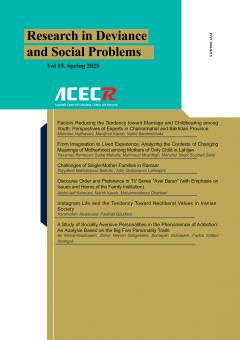-
-
-
Open Access Article
1 - Power Structure and Its Relation to Family Instability (National study in Iranian society)
forozandeh jafarzadehpour -
Open Access Article
2 - The AbortionDue to the Mother's Hardship, in the "Family and Youth of the Population's Protection" Act
Sadegh Shariati Nasab -
Open Access Article
3 - The sociologically study of the Cohabitation in Tehran City
Masoumeh Motlaq mahdieh ghoreishi -
Open Access Article
4 - Changes in the Family in Contemporary Iran Emphasis on Marriage and Divorce
shahla kazemipuor -
Open Access Article
5 - Pathology of Erotic Marriage (Case Study: Women Applying for Divorce in Tehran City)
Sara Tahmanesh bagher sarokhani Akbar Tahmanesh -
Open Access Article
6 - Sociological Analysis of the Cultural Components of Marriage in Persian Tweets
zahra sheikh Bagher saroukhani khadijeh zolghadr -
Open Access Article
7 - Discourse Order and Preference in TV Series "Avai Baran" (with Emphasis on Issues and Harms of the Family Institution)
abdollatif karevani mehdi kaveh mohammadreza ghanbari -
Open Access Article
8 - Challenges of Single-Mother Families in Ramsar
tayebeh bakhshipoor beltorki amir qorbanpoorlafmejani
List of Articles خانواده
-
The rights to this website are owned by the Raimag Press Management System.
Copyright © 2017-2025

